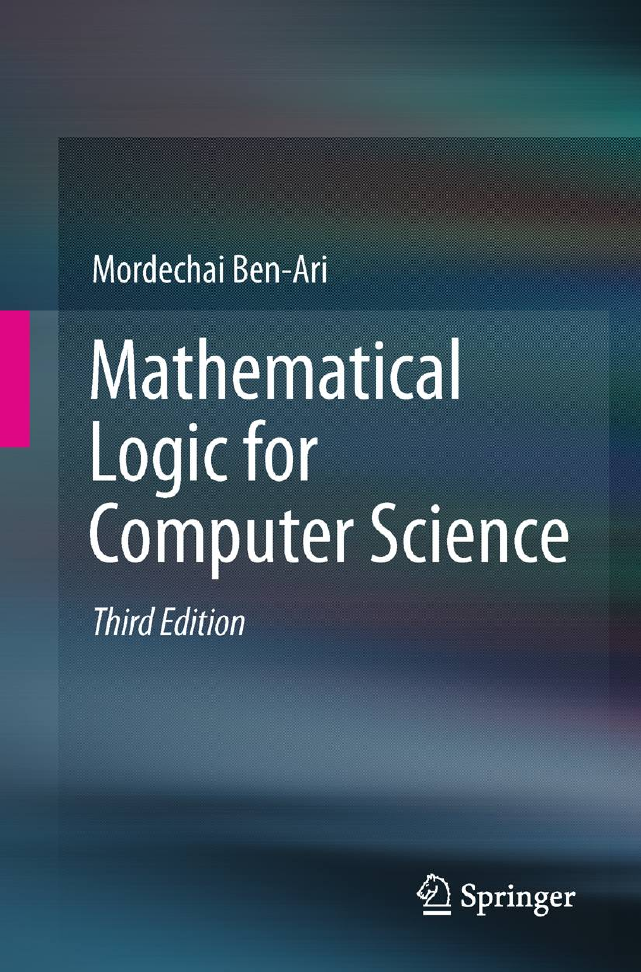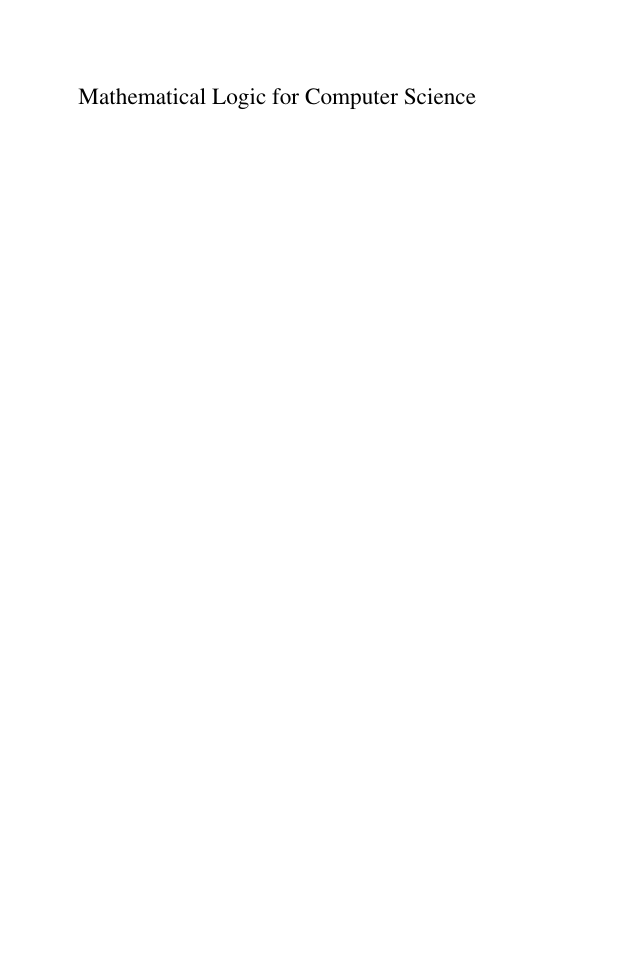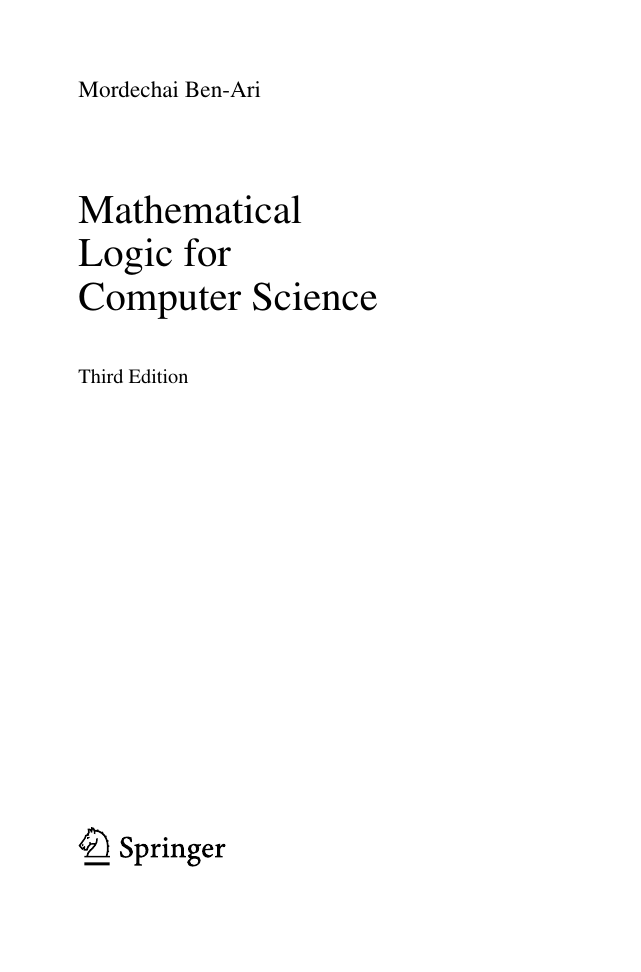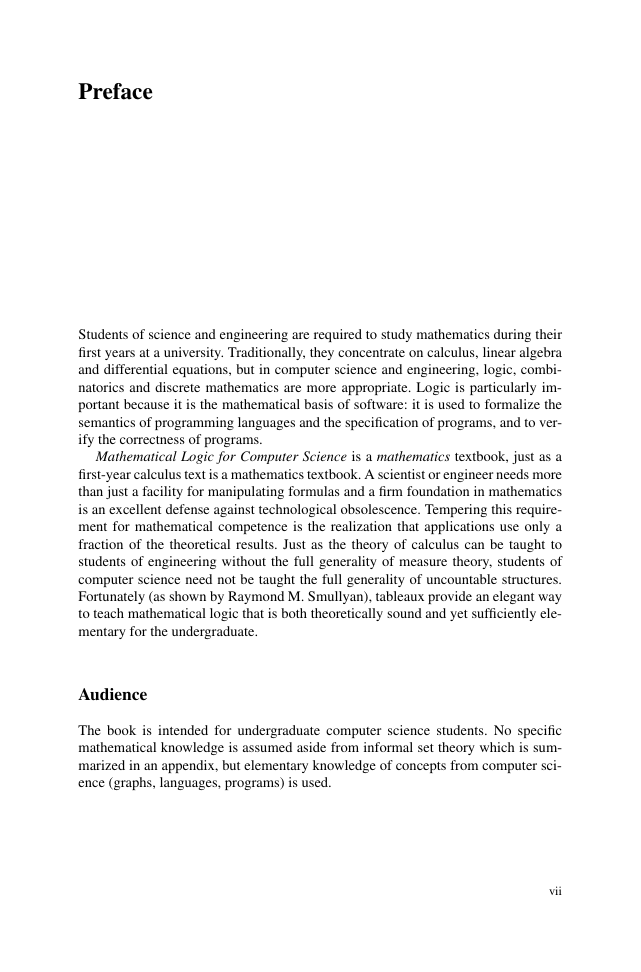Cover
S Title
Title: Mathematical Logic for Computer Science, Third Edition
Copyright
© Springer-Verlag London 2009, 2012
ISBN 978-1-4471-4128-0
ISBN 978-1-4471-4129-7
DOI 10.1007/978-1-4471-4129-7
Dedicated For Anita
Preface
Audience
Organization
Supplementary Materials
Third Edition
Notation
Acknowledgments
Contents
Chapter 1: Introduction
1.1 The Origins of Mathematical Logic
1.2 Propositional Logic
1.3 First-Order Logic
1.4 Modal and Temporal Logics
1.5 Program Verification
1.6 Summary
1.7 Further Reading
1.8 Exercise
References
Chapter 2 Propositional Logic: Formulas, Models, Tableaux
2.1 Propositional Formulas
2.1.1 Formulas as Trees
2.1.2 Formulas as Strings
2.1.3 Resolving Ambiguity in the String Representation
2.1.4 Structural Induction
2.1.5 Notation
2.1.6 A Formal Grammar for Formulas
2.2 Interpretations
2.2.1 The Definition of an Interpretation
2.2.2 Truth Tables
2.2.3 Understanding the Boolean Operators
2.2.4 An Interpretation for a Set of Formulas
2.3 Logical Equivalence
2.3.1 The Relationship Between ↔ and ≣
2.3.2 Substitution
2.3.3 Logically Equivalent Formulas
2.4 Sets of Boolean Operators
2.4.1 Unary and Binary Boolean Operators
2.4.2 Adequate Sets of Operators
2.5 Satisfiability, Validity and Consequence
2.5.1 Decision Procedures in Propositional Logic
2.5.2 Satisfiability of a Set of Formulas
2.5.3 Logical Consequence
2.5.4 Theories
2.6 Semantic Tableaux
2.6.1 Decomposing Formulas into Sets of Literals
2.6.2 Construction of Semantic Tableaux
2.6.3 Termination of the Tableau Construction
2.6.4 Improving the Efficiency of the Algorithm
2.7 Soundness and Completeness
2.7.1 Proof of Soundness
2.7.2 Proof of Completeness
2.8 Summary
2.9 Further Reading
2.10 Exercises
References
Chapter 3 Propositional Logic: Deductive Systems
3.1 Why Deductive Proofs?
3.2 Gentzen System G
3.2.1 The Relationship Between G and Semantic Tableaux
3.3 Hilbert System H
3.3.1 Axiom Schemes and Theorem Schemes
3.3.2 The Deduction Rule
3.4 Derived Rules in H
3.5 Theorems for Other Operators
3.6 Soundness and Completeness of H
3.7 Consistency
3.8 Strong Completeness and Compactness
3.9 Variant Forms of the Deductive Systems
3.9.1 Hilbert Systems
3.9.2 Gentzen Systems
3.9.3 Natural Deduction
3.9.4 Subformula Property
3.10 Summary
3.11 Further Reading
3.12 Exercises
References
Chapter 4 Propositional Logic: Resolution
4.1 Conjunctive Normal Form
4.2 Clausal Form
4.3 Resolution Rule
4.4 Soundness and Completeness of Resolution
4.5 Hard Examples for Resolution
4.5.1 Tseitin Encoding
4.6 Summary
4.7 Further Reading
4.8 Exercises
References
Chapter 5 Propositional Logic: Binary Decision Diagrams
5.1 Motivation Through Truth Tables
5.2 Definition of Binary Decision Diagrams
5.3 Reduced Binary Decision Diagrams
5.4 Ordered Binary Decision Diagrams
5.5 Applying Operators to BDDs
5.6 Restriction and Quantification
5.6.1 Restriction
5.6.2 Quantification
5.7 Summary
5.8 Further Reading
5.9 Exercises
References
Chapter 6 Propositional Logic: SAT Solvers
6.1 Properties of Clausal Form
6.2 Davis-Putnam Algorithm
6.3 DPLL Algorithm
6.4 An Extended Example of the DPLL Algorithm
6.4.1 Encoding the Problem in Propositional Logic
6.4.2 Solving the Problem with the DP Algorithm?
6.4.3 Solving the Problem with the DPLL Algorithm
6.5 Improving the DPLL Algorithm
6.5.1 Branching Heuristics
6.5.2 Non-chronological Backtracking
6.5.3 Learning Conflict Clauses
6.6 Stochastic Algorithms
6.6.1 Solving the 4-Queens Problem with a Stochastic Algorithm
6.7 Complexity of SAT
6.8 Summary
6.9 Further Reading
6.10 Exercises
References
Chapter 7 First-Order Logic: Formulas, Models, Tableaux
7.1 Relations and Predicates
7.2 Formulas in First-Order Logic
7.2.1 Syntax
7.2.2 The Scope of Variables
7.2.3 A Formal Grammar for Formulas
7.3 Interpretations
7.3.1 Closed Formulas
7.3.2 Validity and Satisfiability
7.3.3 An Interpretation for a Set of Formulas
7.4 Logical Equivalence
7.4.1 Logical Equivalences in First-Order Logic
7.5 Semantic Tableaux
7.5.1 Examples for Semantic Tableaux
7.5.2 The Algorithm for Semantic Tableaux
7.6 Soundness and Completion of Semantic Tableaux
7.6.1 Soundness
7.6.2 Completeness
7.7 Summary
7.8 Further Reading
7.9 Exercises
References
Chapter 8 First-Order Logic: Deductive Systems
8.1 Gentzen System G
8.2 Hilbert System H
8.3 Equivalence of H and G
8.4 Proofs of Theorems in H
8.5 The C-Rule
8.6 Summary
8.7 Further Reading
8.8 Exercises
References
Chapter 9 First-Order Logic: Terms and Normal Forms
9.1 First-Order Logic with Functions
9.1.1 Functions and Terms
9.1.2 Formal Grammar
9.1.3 Interpretations
9.1.4 Semantic Tableaux
9.2 PCNF and Clausal Form
9.2.1 Skolem's Theorem
9.2.2 Skolem's Algorithm
9.2.3 Proof of Skolem's Theorem
9.3 Herbrand Models
9.4 Herbrand's Theorem
9.5 Summary
9.6 Further Reading
9.7 Exercises
References
Chapter 10 First-Order Logic: Resolution
10.1 Ground Resolution
10.2 Substitution
10.3 Unification
10.3.1 The Unification Algorithm
10.3.2 The Occurs-Check
10.3.3 The Correctness of the Unification Algorithm
10.3.4 Robinson's Unification Algorithm
10.4 General Resolution
10.5 Soundness and Completeness of General Resolution
10.5.1 Proof of Soundness
10.5.2 Proof of Completeness
10.6 Summary
10.7 Further Reading
10.8 Exercises
References
Chapter 11 First-Order Logic: Logic Programming
11.1 From Formulas in Logic to Logic Programming
11.2 Horn Clauses and SLD-Resolution
11.2.1 Horn Clauses
11.2.2 Correct Answer Substitutions for Horn Clauses
11.2.3 SLD-Resolution
11.3 Search Rules in SLD-Resolution
11.3.1 Possible Outcomes when Attempting a Refutation
11.3.2 SLD-Trees
11.4 Prolog
11.4.1 Depth-First Search
11.4.2 Prolog and the Theory of Logic Programming
11.5 Summary
11.6 Further Reading
11.7 Exercises
References
Chapter 12 First-Order Logic: Undecidability and Model Theory
12.1 Undecidability of First-Order Logic
12.1.1 Two-Register Machines
12.1.2 Church's Theorem
12.2 Decidable Cases of First-Order Logic
12.3 Finite and Infinite Models
12.4 Complete and Incomplete Theories
12.5 Summary
12.6 Further Reading
12.7 Exercises
References
Chapter 13 Temporal Logic: Formulas, Models, Tableaux
13.1 Introduction
13.2 Syntax and Semantics
13.2.1 Syntax
13.2.2 Semantics
13.2.3 Satisfiability and Validity
13.3 Models of Time
13.3.1 Proofs of the Correspondences
13.4 Linear Temporal Logic
13.4.1 Equivalent Formulas in LTL
13.5 Semantic Tableaux
13.5.1 The Tableau Rules for LTL
13.5.2 Construction of Semantic Tableaux
13.5.3 From a Semantic Tableau to a Hintikka Structure
13.5.4 Linear Fulfilling Hintikka Structures
13.5.5 Deciding Fulfillment of Future Formulas
13.6 Binary Temporal Operators
13.7 Summary
13.8 Further Reading
13.9 Exercises
References
Chapter 14 Temporal Logic: A Deductive System
14.1 Deductive System L
14.2 Theorems of L
14.3 Soundness and Completeness of L
14.4 Axioms for the Binary Temporal Operators
14.5 Summary
14.6 Further Reading
14.7 Exercises
References
Chapter 15 Verification of Sequential Programs
15.1 Correctness Formulas
15.2 Deductive System HL
15.3 Program Verification
15.3.1 Total Correctness
15.4 Program Synthesis
15.4.1 Solution 1
15.4.2 Solution 2
15.5 Formal Semantics of Programs
15.5.1 Weakest Preconditions
15.5.2 Semantics of a Fragment of a Programming Language
15.5.3 Theorems on Weakest Preconditions
15.6 Soundness and Completeness of HL
15.7 Summary
15.8 Further Reading
15.9 Exercises
References
Chapter 16 Verification of Concurrent Programs
16.1 Definition of Concurrent Programs
16.2 Formalization of Correctness
16.2.1 An Abbreviated Algorithm
16.3 Deductive Verification of Concurrent Programs
16.4 Programs as Automata
16.4.1 Modeling Concurrent Programs as Automata
16.4.2 The State Space
16.5 Model Checking of Invariance Properties
16.5.1 Algorithms for Searching the State Space
16.5.2 On-the-Fly Searching
16.6 Model Checking of Liveness Properties
16.7 Expressing an LTL Formula as an Automaton
16.8 Model Checking Using the Synchronous Automaton
16.9 Branching-Time Temporal Logic
16.9.1 The Syntax and Semantics of CTL
16.9.2 Model Checking in CTL
16.10 Symbolic Model Checking
16.11 Summary
16.12 Further Reading
16.13 Exercises
References
Appendix: Set Theory
A.1 Finite and Infinite Sets
A.2 Set Operators
A.3 Sequences
A.4 Relations and Functions
A.5 Cardinality
A.6 Proving Properties of Sets
References
Index of Symbols
Name Index
Subject Index
















 2023年江西萍乡中考道德与法治真题及答案.doc
2023年江西萍乡中考道德与法治真题及答案.doc 2012年重庆南川中考生物真题及答案.doc
2012年重庆南川中考生物真题及答案.doc 2013年江西师范大学地理学综合及文艺理论基础考研真题.doc
2013年江西师范大学地理学综合及文艺理论基础考研真题.doc 2020年四川甘孜小升初语文真题及答案I卷.doc
2020年四川甘孜小升初语文真题及答案I卷.doc 2020年注册岩土工程师专业基础考试真题及答案.doc
2020年注册岩土工程师专业基础考试真题及答案.doc 2023-2024学年福建省厦门市九年级上学期数学月考试题及答案.doc
2023-2024学年福建省厦门市九年级上学期数学月考试题及答案.doc 2021-2022学年辽宁省沈阳市大东区九年级上学期语文期末试题及答案.doc
2021-2022学年辽宁省沈阳市大东区九年级上学期语文期末试题及答案.doc 2022-2023学年北京东城区初三第一学期物理期末试卷及答案.doc
2022-2023学年北京东城区初三第一学期物理期末试卷及答案.doc 2018上半年江西教师资格初中地理学科知识与教学能力真题及答案.doc
2018上半年江西教师资格初中地理学科知识与教学能力真题及答案.doc 2012年河北国家公务员申论考试真题及答案-省级.doc
2012年河北国家公务员申论考试真题及答案-省级.doc 2020-2021学年江苏省扬州市江都区邵樊片九年级上学期数学第一次质量检测试题及答案.doc
2020-2021学年江苏省扬州市江都区邵樊片九年级上学期数学第一次质量检测试题及答案.doc 2022下半年黑龙江教师资格证中学综合素质真题及答案.doc
2022下半年黑龙江教师资格证中学综合素质真题及答案.doc